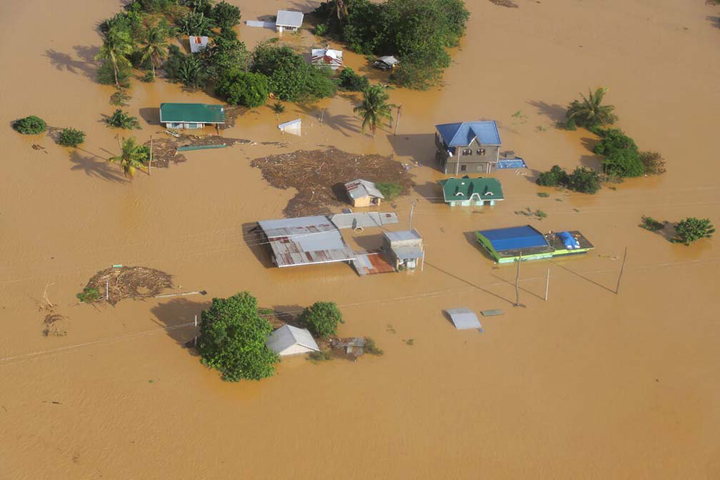
CLIMATE-RELATED hazards resulted in an estimated P506.1 billion (about $10 billion) in losses and damage for the Philippines in over a decade, the Department of Finance (DOF) said.
Based on DOF data, this already makes up 98.2 percent of the country’s total estimated losses and damage of P515.1 billion (around $10.6 billion) from 2010 to 2020. Annually, this is equivalent to an average of P48.9 billion, which is about 0.33 percent of the GDP. This, despite the Philippines contributing only 0.3 percent of the planet’s total greenhouse gas emissions.
The DOF said this shows the country’s “extreme vulnerability to the climate crisis,” adding that the Philippines constantly experiences unavoidable losses and damage amounting to 0.5 percent of its annual GDP primarily from an increasingly unpredictable climate.
Every year, the Philippines is struck by around 20 tropical cyclones and an almost daily occurrence of seismic shocks.
Being a climate-vulnerable country, the Philippines has much at stake in reversing the devastating effects of global warming, Finance Secretary Carlos Dominguez III said.
“As I have said on many occasions, I am determined to set the Philippines as an example for all nations in setting the standards for mitigating the impact of climate change. I want us to be a world leader in this area through our climate ambition,” said Dominguez.
Dominguez, who is chairman-designate of the Climate Change Commission (CCC), heads the Philippine delegation to the ongoing 26th United Nations Climate Change Conference of the Parties (COP26) in Glasgow, Scotland.
At the opening of the 2021 Annual Meeting of the Asian Infrastructure Investment Bank (AIIB), Dominguez earlier called on Western countries that are largely responsible for the most GHG emissions to act now in significantly reducing their carbon footprints, and to make good on their commitments to extend the financing needed by climate-vulnerable countries to transition to a clean energy future.
The finance chief said earlier the need for these countries to accept the responsibility of financing the transition to carbon neutrality.
The Philippines has committed to a projected greenhouse gas emission reduction and avoidance of 75 percent from 2020 to 2030 for the sectors of agriculture, wastes, industry, transport, and energy, as its National Determined Contribution (NDC) to the Paris Agreement.
Fiscal risk statement
According to the DOF, the latest Fiscal Risk Statement (FRS) released this year by the Bureau of the Treasury (BTr) “cites the country’s exposure to natural disasters as a major source of downside risks for the national government’s fiscal position.”
The FRS is drawn up annually to identify the fiscal risks to which the Philippines is exposed to, and at the same time, outlines the key programs and measures put up by the government to manage these risks.
In 2020 alone, based on the preliminary 2022 FRS, P74.75 billion worth (approximately $1.49 billion) of damage was recorded—resulting from disasters, including three consecutive typhoons that collectively caused the largest damage of P69.02 billion (approximately $1.38 billion). Economic losses were estimated at P35.74 billion (approximately $714.8 million).
In 2019, a single tropical cyclone—Typhoon Tisoy (international code name Kammuri)—recorded the most damage at P6.6 billion (approximately $132.0 million), of which P2.9 billion (approximately $58 million) and P3.7 billion (approximately $74 million) pertain to infrastructure and agriculture damage, respectively, the DOF said.
Losses and damage from extreme weather events reached 4 percent of GDP in 2013 as a result of Supertyphoon Yolanda (international code name Haiyan), which killed over 6,000 people, according to the National Disaster Risk Reduction and Management Council (NDRRMC).
9th most weather-affected country
Based on the 2020 World Risk Index, the Philippines ranked 9th out of 181 nations in the world as the most affected country from extreme weather events.
Meanwhile, the Philippines ranked 4th among 10 countries most severely hit by extreme weather events from 2000 to 2019.
Being an archipelago, the Philippines is also greatly threatened by rising sea levels as an offshoot of global warming.
Based on satellite observations, the level of the Philippines’s surrounding seas has increased at a rate of 5.7-7.0 mm/year from 1993 to 2015, twice the highest global average rate of 2.8-3.6 mm/year observed between 1993 and 2010.
Sea level rise, which has been identified by the CCC’s reconstituted National Panel of Technical Experts (NPTE) among the top 10 climate-induced risks in the country, is putting at extreme risk 64 coastal provinces, 822 coastal municipalities and 25 major coastal cities.
The country lost about 68 percent and 82 percent corals and seagrass cover, respectively, from 2009-2016, which was exacerbated by climate change impacts, such as coral bleaching and ocean acidification. This accelerated fish catch depletion as commercial fish move from warm to cooler and deep waters.
Image courtesy of Philippine Coast Guard via AP

